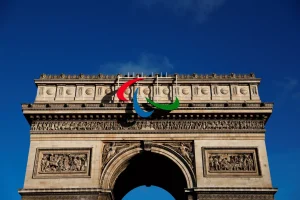Teeming with human life in all its diversity, famous – amongst other things – for its skyscrapers, much of our fascination with La Défense stems from its cosmopolitan identity! But did you realize that Paris’ most famous business district is also an open-air art gallery? Follow us and discover, perhaps for the first time, five of our favourite masterpieces. It will surely be the first time you won’t be stopped for bringing your bicycle into a museum!

Starting point: Station n°92007 Pesaro – Préfecture
Finishing point: Station n°22008 Charles de Gaulle – Graviers
Distance travelled: environ 4 km
Journey time: approx. 1 hour 15 minutes – the itinerary is relatively flat apart from the approach to the main pedestrian concourse at la Défense
Directions: take the Boulevard de Pesaro cycle path and head towards the Grande Arche. It probably looks huge to you, doesn’t it? That’s to be expected, Notre-Dame cathedral could fit inside it! At the end of the boulevard, continue along the Esplanade Arena, passing in front of the Paris La Défense Arena. Keeping La Jetée (a raised boardwalk) on your left, continue along the Promenade de l’Arche and then head towards the Valmy district and the Spaces – La Défense office building.
Topsy-turvy with La voiture sur le lampadaire (Car on a lamp-post)

©Jscariot on Wikicommons – La voiture sur le lampadaire – Benedetto Bufalino
Are you ready to discover the first artwork in our open-air gallery? It’s pretty hard to miss. No, you’re not dreaming, there is indeed a white Peugeot 406 upside down on top of a street light! From four metres up in the air, it lights up the area by night and catches the eyes of passers-by – a strange vision in surroundings that are dominated by concrete and stone. It’s an everyday object with a twist in a part of the city where business reigns supreme and there’s little time for jokes. This work is also a nod to one of the things that makes La Défense different: it’s a space entirely given over to pedestrians and eco-friendly methods of transportation. Cars are nowhere to be seen, except in the car parks beneath our feet. Here, the world is very much shown in a ‘topsy-turvy’ light! This work expresses artist Benedetto Bufalino’s commitment to the environment. He’s a huge fan of cycling who doesn’t mince his words: ‘I’m opposed to cars, we need to put a stop to to this monstrosity’.
La voiture sur le lampadaire was created for the second ‘Les Extatiques’ exhibition in 2019. But what exactly is ‘Les Extatiques’? Well, it’s an annual contemporary art exhibition which first began as part of the 60th anniversary celebrations of La Défense in 2018! Since then, every year a new exhibition puts art front and centre.
Directions: follow the green line on the ground, which is specifically for the use of cyclists and go round the Grande Arche on the right-hand side. You’ll arrive at the Parvis de l’Arche de La Défense (Paris side, east façade). On your right-hand side you’ll find a large staircase decorated with colourful tiles which leads towards Le Dôme. This is called ‘l’Escalier’ and it’s by Piotr Kowalski! Admire the multi-coloured glazed earthenware and head off in the opposite direction to l’Escalier, to the left of the CNIT, towards the giant thumb on Place Carpeaux.
Thumbs up for the ‘Pouce de César’

©Shadowgate on flickr – Le Pouce, César
Who could have imagined that one of the smallest parts of the body could grow up to 12 metres long and weigh 18 tonnes? An exhibition on the theme of ‘the hand’ afforded the perfect opportunity for artist César Baldaccini, simply known as ‘César’, to use his own thumb as a model to create a series of sculptures of differing sizes. The example before you may be the largest version made, but identical versions can be seen elsewhere in the world such as Seoul, Washington DC or Koblenz, to name just a few!
The symbolism of this work of art is all the stronger here. Although it may seem strange for there to be a reference to manual trades in the heart of a business quarter, such an imposing, proud object, with maybe even a touch of vanity about it, pointing skywards, confronts us with our own narcissistic tendencies. In today’s society, it’s a way of demonstrating agreement; taken together with the artist’s name, Caesar, it’s also a reminder that the Emperor had the power of life and death in Roman times. Should we see this as an encouragement or a warning to those who wander through the hustle and bustle of La Défense?
Some find it provocative, others enigmatic. What is sure is that this work of art is always thought-provoking, much to the delight of those who walk past it.
Directions: follow the green line on the ground behind the Thumb for a few metres which will bring you to some boom barriers. Go through the cycle barrier. Go down the two-way cycle path towards the Boulevard Circulaire. Continue along this cycle path until you reach n°10 on this street (also called the N13) where the verdant depiction of La Famille cycliste (the family of cyclists) will unfold before you in the shape of a mural!
Scenes from an urban jungle: La Famille cycliste

©Paris la Défense – La famille cycliste by Catherine Feff
If you’re doing this itinerary with your children, you’re sure to identify with this snapshot of a paradisiacal world… Artist Catherine Feff drew inspiration from her nearest and dearest (her son and one of her closest friends) to create it! Painted in 2007, this design feels like it has been something of a good omen for lovers of cycling – in years gone by, bicycles were forbidden on La Défense’s pedestrian concourse. Brought in from the cold in 2015 on the back of the ‘Love Story sur le parvis’ scheme which aimed to encourage mutual respect between users of different means of transport, bicycles have gradually returned in increasing numbers in the shadow of the skyscrapers. The arrival of cyclists to the area over the past few years led to the construction in 2020 of the cycle path on which you currently find yourself, marking a new form of co-existence between pedestrians and cyclists.
Directions: Continue along the cycle path. Take the next right turn onto Avenue Albert Gleizes. Be sure to stay on the cycle path. Cross Rue Henri Regnault. Just at the foot of the Total skyscraper, a bicycle and pedestrian access route will take you to the pedestrian concourse level of La Défense. Go through the bicycle boom barrier to get onto the route and follow the green line which leads you up a ramp to the right of the stairway. You’ll go underneath a building to arrive in front of a very large red metal sculpture… arachnophobes, don’t go just yet!
Shake hands, I mean, feet, with the Araignée Rouge (the Red Spider)!

©Philippe L PhotoGraphy on flickr – The Araignée by Calder
Alexander Calder might almost (we did say almost) make you love the natural world’s most famous spinner! L’Araignée Rouge is one of La Défense’s most iconic works of art. Built by a mix of labourers and engineers, made out of steel painted red, it’s 15 metres-high and weighs 75 tonnes. In fact, a stairway had to be moved to make way for our favourite arachnid, changing the pedestrian concourse’s lay-out for ever. If you’re a bit of a globe-trotter, the Araignée Rouge will surely remind you of Chicago, where ‘Flamingo’, a similar work by Calder, is tucked away. For the more Franco-centric amongst us, Calder’s style might also bring to mind the famous ‘Iron Lady’, whose silhouette dominates the Paris skyline…
There is a French saying, ‘Araignée du matin, chagrin’ (Spider in the morrow, sorrow), which is about forecasting rain, but we prefer its companion saying, ‘araignée du soir, espoir!’ (Spider in the evening, hope). In any case, you don’t need a special reason to pass by and say hi, at any time of the day or night.
Directions: Bear left, after a short distance you’ll see a water feature on your right. Turn down towards it and on your left you’ll see a 19th century sculpture of a woman in uniform and a soldier. It’s called ‘La Défense de Paris’ (the defence of Paris).
The heart of La Défense, the heart of the exhibition

©Steve Collis on flickr – La Défense de Paris by Louis-Ernest Barrias
We’ll finish this itinerary with the centrepiece of our open-air exhibition, at the very heart of the district, the statue of ‘La Défense de Paris’. In fact, it’s this statue which gave the whole area its name! Unveiled on October 12th, 1883, it commemorates the defence of the city against the Prussian army in 1871. The young girl to the rear appears crushed, she represents the sufferings experienced by the city’s inhabitants during this period. The statue has moved location several times, always, however, being sited directly in line with the most beautiful street in the world, the Champs-Élysées. This unique angle enables you to see the Arc de Triomphe in one direction and the Grande Arche in the other.
Another fun fact: take a look at the EDF tower near the statue. It was designed by I. M. Pei. Does that name seem somehow familiar? Well, he’s the architect who created the Louvre Pyramid! This tower probably seems very large in comparison with the other skyscrapers in the business district, as indeed it should – its culminating point is directly level with the top of the Grande Arche.
Directions: facing the statue you’ll see a water feature tiled in a mosaic design. Head back towards the Araignée Rouge, go around the building works and head towards the Tour EDF. You’ll come to the area of railings at the foot of the EDF tower (now called ‘Légende’), from which you have a good view of the cascade part of the water feature.
Close your eyes for a moment, focus hard – and your bicycle is transformed into a gondola: welcome to Venice! Lose yourself in the kaleidoscope of 86 subtly different shades of ‘pâte de verre’ glass making up this fountain. It’s special in that it has an operating system that’s found almost nowhere else, one that creates the impression of ‘balls’ of water shooting into the air. The water then drops down in a seven metre-high waterfall which flows into Place de la Défense. An entrancing spectacle for young and old alike during the summertime!
Directions: follow the green line which drops down a level by a few metres; keep roughly in line with the Grande Arche-Arc de Triomphe line. This will help you avoid staircases and will take you to the banc public géant (the Giant bench) Need a rest? Then become both work of art and artist at the same time by sitting on it! Ensconced on your throne, enjoy the view over the pool designed by Vassilakis Panayotis with its 49 multi-coloured lights arising out of the water. A nice touch is the way in which these light signals mark the entrance to and exit from La Défense, a bit like beacons do for a harbour at night-time.
If you’re done with resting, follow the green line on the ground, which will lead you round the left-hand side of the pool. Then you’ll take the gentle incline leading to the passerelle de l’Aigle. Take this raised cycleway to get onto the pont de Neuilly. Once over the bridge, follow the cycle path along Avenue Charles de Gaulle, as far as the Rond-point de la fontaine de Madrid. Feel free to cross over on foot, using the pedestrian crossings! Station Vélib’ 22005 (Charles de Gaulle – Madrid) is located on the other side of the roundabout, a few metres along Avenue Charles de Gaulle.

